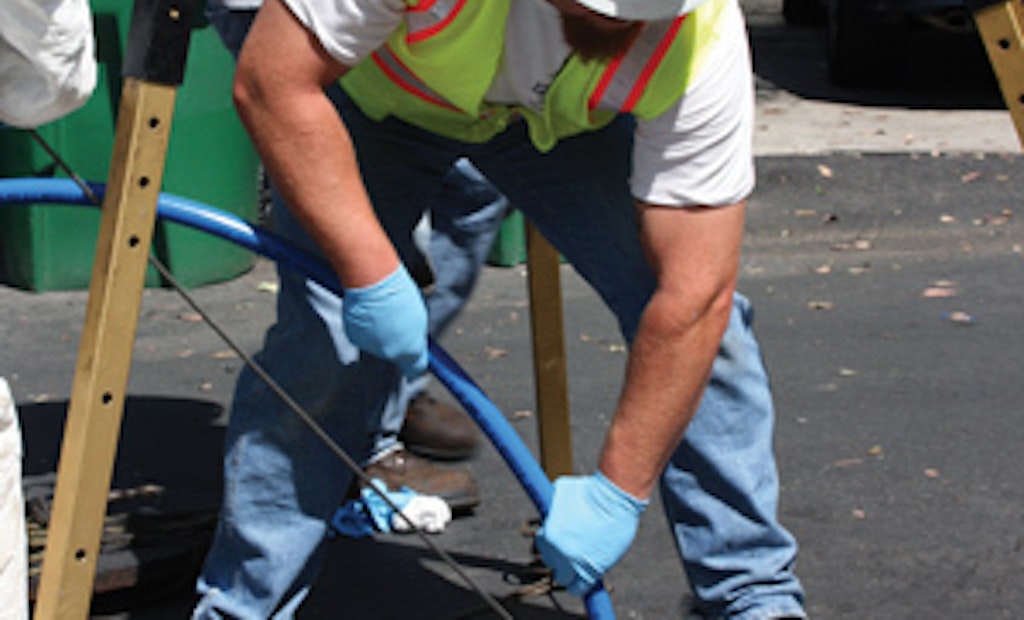
Interested in Plumbing?
Get Plumbing articles, news and videos right in your inbox! Sign up now.
Plumbing + Get AlertsGroves of eucalyptus trees in the City of Lake Forest, Calif., provided abundant landscaping for residents and severe root problems for the Irvine Ranch Water District. Despite crews cleaning hot spots three times per month and treating roots with chemical foam, blockages continued to surcharge manholes and back up sewage into homes.
In 2010, the city requested proposals to line 8- to 10-inch clay sewer mains, manholes, and 780 4-inch clay laterals. Insituform Technologies won the bid and subcontracted Quality Pipe Services of Denver, Colo., to line the service connections. About 70 percent of them had massive root balls where they tied into the gravity mains.
“Eucalyptus roots grow fast and are very fine, enabling them to form huge, dense clumps,” says operations manager Larry Kammerlohr. “It’s a problem you can’t appreciate until you see it, and I hope I don’t see something like that again for a really long time.” His six men worked six months to complete the Woods Project successfully.
Multiple effort
As Insituform finished lining the mains with cured-in-place pipe, Kammerlohr’s team notified homeowners that the lining process would block their service for about an hour. Then his cleaning crew worked for two days to always stay ahead of the lining crew.
Working manhole to manhole, one man operated the OmniEYE 3 mainline camera on a TransSTAR wheeled transporter in the RS Technical Services inspection van, while the other attacked the roots with a Warthog nozzle from StoneAge Tools. A 300-gallon trailer-mounted Model 183 jetter from Mongoose Jetters supplied water at 18 gpm/3,000 psi. A screen in the downstream manhole caught the debris, which was stored in a 55-gallon trash can and emptied in a dumpster at the end of each day.
“The guys spent 20 to 25 minutes cutting roots for 24 inches up each lateral,” says Kammerlohr. “They got the pipe 85 to 90 percent clean. In most cases, it was in good condition except for the root infiltration.”
Many trunk lines were in easements along a creek bed. “We could drive to the creek, but the manholes were 100 feet away,” says Kammerlohr. “It took 90 minutes or more to carry in all the equipment and set it up.”
Lateral lining train
Because the contract specified lining 18 to 24 inches to cover the first two joints of the laterals, Kammerlohr selected the BLD service connection seal from BLD Services.
“It can go the distance,” he says. “The polyester felt liner also has a semi-ridged flange on which we apply hydrophilic caulking to create a watertight seal.”
Lining the laterals required the inspection van, BLD wet-out trailer, a pull-behind trailer with a 385 Ingersoll Rand air compressor and winches for the air hose and lateral launch assembly cable, and four workers. After Chad Ritter inspected the lateral for debris using the mainline camera, Tony Bergipen and foreman Wayne Powers vacuum impregnated a liner in the wet-out trailer. They kept the resin refrigerated to give the crew 30 minutes of working time.
Meanwhile, Kammerlohr attached the cable and air hose to a pressure tube and inflated the lateral bladder. Armand Moinzad lubricated it with solid shortening so it retracted into the tube and inverted properly with air pressure. They then caulked the backside of the flange on the liner and loaded it into the inversion bladder.
Following OSHA confined-space entry standards, Powers and Moinzad lowered the assembly to Bergipen in the manhole. After he positioned the unit in the main, a camera mounted on the tube enabled Ritter to control the speed of the winch and position the launcher at the opening of the lateral. Air pressure at 18 psi propelled the liner up the lateral and held it in place until the resin ambient-cured in 45 to 60 minutes. Ritter then deflated the inversion bladder and retracted the tube.
“We also did a couple of installs on 10- and 15-inch mains where we had to bypass and work at night,” says Kammerlohr. “We were in subdivisions or easements, so traffic wasn’t an issue.”
The team lined five or six laterals per day and completed the project in just less than six months. The district now inspects the mains monthly.








